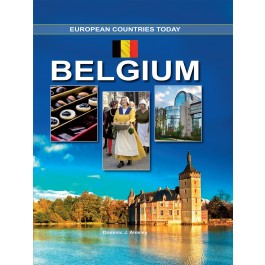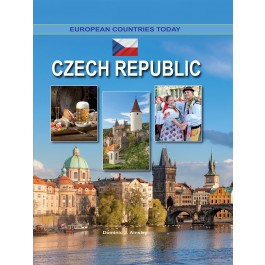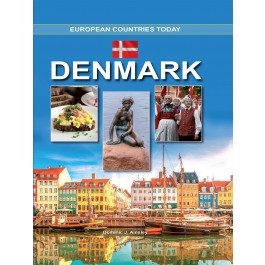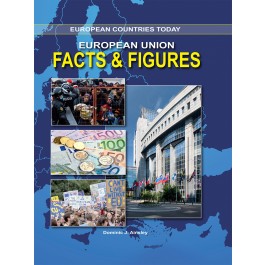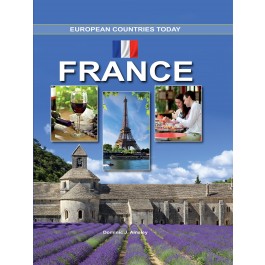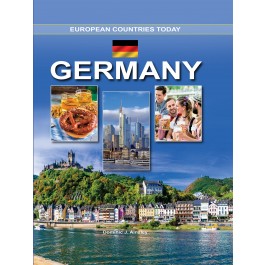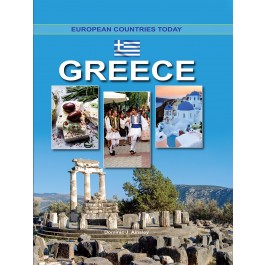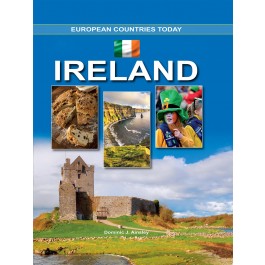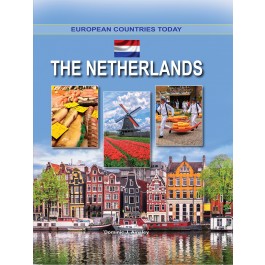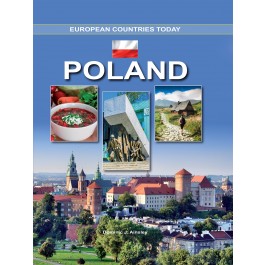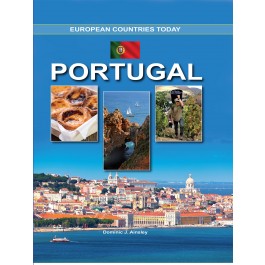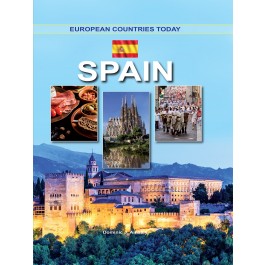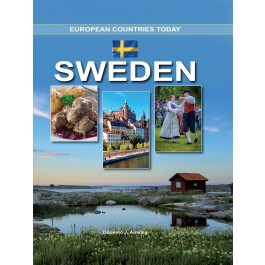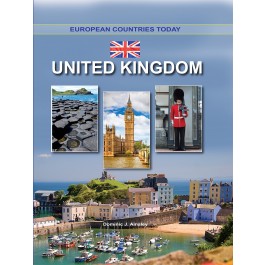EUROPEAN COUNTRIES TODAY

16
2019
12+
7th - 12th
7 x 9
by Dominic J. Ainsley
| Hardcover | ISBN 978-1-4222-3978-0 | $25.95 | Add To Cart |
| eBook | ISBN 978-1-4222-7793-5 | $32.95 | Add To Cart |
A prosperous, democratic country, Austria joined the EU in 1995. It has a well-developed market economy, having modern agricultural and industrial sectors and a high standard of living. It has a thriving tourist scene based around its historic cities and winter sports facilities. Austria is a landlocked country bordered by Germany, the Czech Republic, Slovakia, Hungary, Slovenia, Italy, Switzerland, and Liechtenstein. Geographically, Austria can be split into two: the Alpine zone to the southwest, and the Danube lowlands with the Vienna plain to the northeast. Here, the land rises towards the Bohemian Forest and Moravian heights of Slovakia. The Austrian Alps are lower and more accessible than those of Switzerland, and are dissected by the long, wide, Brenner, Arlberg, Semmering, and Schober passes. The European Countries Today series provides information on 15 of the most important countries in Europe. Each book in the series describes the history, geography, economy, culture, and
relationship each country has with its neighbors. There is also a separate title, European Union Facts & Figures, which provides statistical and factual information about the European Union. Each title in this series includes color photos throughout, and back matter including: an index and further reading lists for books and internet resources. Key Icons appear throughout the books in this series in an effort to encourage library readers to build knowledge, gain awareness, explore possibilities and expand their viewpoints through our content rich non-fiction books. Key Icons in this series are as follows: Words to Understand are shown at the front of each chapter with definitions. These words are set in boldfaced type in that chapter, so that readers are able to reference back to the definitions--building their vocabulary and enhancing their reading comprehension. Sidebars are highlighted graphics with content rich material within that allows readers to build knowledge and broaden their perspectives by weaving together additional information to provide realistic and holistic perspectives. Educational Videos are offered in chapters through the use of a QR code, that, when scanned, takes the student to an online video showing a moment in history, a speech, or an instructional video. This gives the readers additional content to supplement the text. Text-Dependent Questions are placed at the end of each chapter. They challenge the reader’s comprehension of the chapter they have just read, while sending the reader back to the text for more careful attention to the evidence presented there. Research Projects are provided at the end of each chapter as well and provide readers with suggestions for projects that encourage deeper research and analysis.
by Dominic J. Ainsley
| Hardcover | ISBN 978-1-4222-3979-7 | $25.95 | Add To Cart |
| eBook | ISBN 978-1-4222-7794-2 | $32.95 | Add To Cart |
A country of Western Europe, Belgium has a coastline on the North Sea but is otherwise surrounded by the Netherlands, Germany, Luxembourg, and France. It is characterized by the Ardennes in the southeast, and drained lowland plains by the rivers Meuse and Scheldt. Flemish is spoken mainly in Flanders in the north, and French and Walloon, a French dialect, in Wallonia in the south. Belgium made a rapid recovery after World War II and has made economic progress ever since. It became one of the Benelux countries, with the Netherlands and Luxembourg, in 1948. This, and the geography of its position, gave it significant influence in Europe, and it became a founder member of the European Union, with Brussels now providing the administrative headquarters of the organization. The European Countries Today series provides information on the 15 of the most important countries in Europe. Each book in the series describes the history, geography, economy, culture, and relationship each country has
with its neighbors. Thereis also a separate title, European Union Facts & Figures, which provides statistical and factual information about the European Union. Each title in this series includes color photos throughout, and back matter including: an index and further reading lists for books and internet resources. Key Icons appear throughout the books in this series in an effort to encourage library readers to build knowledge, gain awareness, explore possibilities and expand their viewpoints through our content rich non-fiction books. Key Icons in this series are as follows: Words to Understand are shown at the front of each chapter with definitions. These words are set in boldfaced type in that chapter, so that readers are able to reference back to the definitions--building their vocabulary and enhancing their reading comprehension. Sidebars are highlighted graphics with content rich material within that allows readers to build knowledge and broaden their perspectives by weaving together additional information to provide realistic and holistic perspectives. Educational Videos are offered in chapters through the use of a QR code, that, when scanned, takes the student to an online video showing a moment in history, a speech, or an instructional video. This gives the readers additional content to supplement the text. Text-Dependent Questions are placed at the end of each chapter. They challenge the reader’s comprehension of the chapter they have just read, while sending the reader back to the text for more careful attention to the evidence presented there. Research Projects are provided at the end of each chapter as well and provide readers with suggestions for projects that encourage deeper research and analysis.
by Dominic J. Ainsley
| Hardcover | ISBN 978-1-4222-3980-3 | $25.95 | Add To Cart |
| eBook | ISBN 978-1-4222-7795-9 | $32.95 | Add To Cart |
On January 1, 1993, Czechoslovakia was divided into two entities: the Czech Republic and the Republic of Slovakia. The Czech Republic now occupies about two-thirds of the area that once was Czechoslovakia, and consists of the Bohemian plateau in the east and the Moravian lowlands to the west. Mountains form most of the republic’s northern border with Germany and Poland. Czechoslovakia was occupied by Germany during World War II, but the Communists emerged as the strongest party in 1946 and by 1948 their grip on the country had tightened. The country remained under the Communists until 1989 when the “Velvet Revolution” ensured a relatively painless transition towards a non-Communist government. In 1992 the government agreed to the partition of Czechoslovakia, and the Czech and Slovak Republics were born the following year. Since Communism, private ownership of land has increased, and crops including hops, grains, and fruits are grown. The Czech Republic has mineral reserves, and
machinery and vehicles are produced for export. The European Countries Today series provides information on 15 of the most important countries in Europe. Each book in the series describes the history, geography, economy, culture, and relationship each country has with its neighbors. There is also a separate title, European Union Facts & Figures, which provides statistical and factual information about the European Union. Each title in this series includes color photos throughout, and back matter including: an index and further reading lists for books and internet resources. Key Icons appear throughout the books in this series in an effort to encourage library readers to build knowledge, gain awareness, explore possibilities and expand their viewpoints through our content rich non-fiction books. Key Icons in this series are as follows: Words to Understand are shown at the front of each chapter with definitions. These words are set in boldfaced type in that chapter, so that readers are able to reference back to the definitions--building their vocabulary and enhancing their reading comprehension. Sidebars are highlighted graphics with content rich material within that allows readers to build knowledge and broaden their perspectives by weaving together additional information to provide realistic and holistic perspectives. Educational Videos are offered in chapters through the use of a QR code, that, when scanned, takes the student to an online video showing a moment in history, a speech, or an instructional video. This gives the readers additional content to supplement the text. Text-Dependent Questions are placed at the end of each chapter. They challenge the reader’s comprehension of the chapter they have just read, while sending the reader back to the text for more careful attention to the evidence presented there. Research Projects are provided at the end of each chapter as well and provide readers with suggestions for projects that encourage deeper research an
by Dominic J. Ainsley
| Hardcover | ISBN 978-1-4222-3981-0 | $25.95 | Add To Cart |
| eBook | ISBN 978-1-4222-7796-6 | $32.95 | Add To Cart |
Denmark is a kingdom of northwest Europe bordering the North and Baltic Seas. It occupies the northern two-thirds of the Jutland Peninsula, together with the islands lying between the peninsula and Sweden. During World War II, Denmark was invaded by Germany, but offered strong resistance throughout the occupation. Denmark joined NATO in 1949 and in 1973, together with Britain, entered the EU. Today, Denmark is a prosperous, progressive, and thoroughly modern country with an enviable social-welfare system. Industries include dairy products, cereals, sugar beet, fish, iron, steel, chemicals, electronics, wooden products and furniture, and shipbuilding. The Faroes, a group of islands in the north Atlantic, between Iceland and the Shetland Islands, also belong to Denmark, though they have been partly autonomous since 1948. The European Countries Today series provides information on 15 of the most important countries in Europe. Each book in the series describes the history, geography,
economy, culture, and relationship each country has with its neighbors. There is also a separate title, European Union Facts & Figures, which provides statistical and factual information about the European Union. Each title in this series includes color photos throughout, and back matter including: an index and further reading lists for books and internet resources. Key Icons appear throughout the books in this series in an effort to encourage library readers to build knowledge, gain awareness, explore possibilities and expand their viewpoints through our content rich non-fiction books. Key Icons in this series are as follows: Words to Understand are shown at the front of each chapter with definitions. These words are set in boldfaced type in that chapter, so that readers are able to reference back to the definitions--building their vocabulary and enhancing their reading comprehension. Sidebars are highlighted graphics with content rich material within that allows readers to build knowledge and broaden their perspectives by weaving together additional information to provide realistic and holistic perspectives. Educational Videos are offered in chapters through the use of a QR code, that, when scanned, takes the student to an online video showing a moment in history, a speech, or an instructional video. This gives the readers additional content to supplement the text. Text-Dependent Questions are placed at the end of each chapter. They challenge the reader’s comprehension of the chapter they have just read, while sending the reader back to the text for more careful attention to the evidence presented there. Research Projects are provided at the end of each chapter as well and provide readers with suggestions for projects that encourage deeper research and analysis.
by Dominic J. Ainsley
| Hardcover | ISBN 978-1-4222-3982-7 | $25.95 | Add To Cart |
| eBook | ISBN 978-1-4222-7797-3 | $32.95 | Add To Cart |
The European Union (EU) consists of 28 countries, spanning the European continent from Ireland in the west to the border of Russia in the east. Any European country with a democratic government, a functioning market economy, respect for fundamental rights, and a government capable of implementing EU laws and policies may apply for membership. The EU is neither a nation, nor an international organization, nor is it intended to replace existing nations. This book provides interesting information along with all the facts and figures currently available that relate to the EU. It also explains how the EU and its economy operates, what it does for its members, and how it promotes freedom, justice, and security. The European Countries Today series provides information on the subject of 15 of the most important countries in Europe. Each book in the series describes the history, geography, economy, culture, and relationship each country has with its neighbors. This title, European Union Facts &
Figures, provides statistical and factual information about the European Union. Each title in this series includes color photos throughout, and back matter including: an index and further reading lists for books and internet resources. Key Icons appear throughout the books in this series in an effort to encourage library readers to build knowledge, gain awareness, explore possibilities and expand their viewpoints through our content rich non-fiction books. Key Icons in this series are as follows: Words to Understand are shown at the front of each chapter with definitions. These words are set in boldfaced type in that chapter, so that readers are able to reference back to the definitions--building their vocabulary and enhancing their reading comprehension. Sidebars are highlighted graphics with content rich material within that allows readers to build knowledge and broaden their perspectives by weaving together additional information to provide realistic and holistic perspectives. Educational Videos are offered in chapters through the use of a QR code, that, when scanned, takes the student to an online video showing a moment in history, a speech, or an instructional video. This gives the readers additional content to supplement the text. Text-Dependent Questions are placed at the end of each chapter. They challenge the reader’s comprehension of the chapter they have just read, while sending the reader back to the text for more careful attention to the evidence presented there. Research Projects are provided at the end of each chapter as well and provide readers with suggestions for projects that encourage deeper research and analysis.
by Dominic J. Ainsley
| Hardcover | ISBN 978-1-4222-3983-4 | $25.95 | Add To Cart |
| eBook | ISBN 978-1-4222-7798-0 | $32.95 | Add To Cart |
France, one of the most important countries in Europe, encompasses medieval cities, alpine villages, and Mediterranean beaches. Paris, its capital, is famed for its fashion houses, classical art museums, and monuments like the Eiffel Tower and the Arc de Triomphe. France is also famous for its wines and superior cuisine. Lascaux’s ancient cave drawings, Lyon’s Roman theater, and the vast Palace of Versailles attest to its rich history. As one of the six founding members of what later became the European Union back in 1952, and the largest country participating in the organization today, France still holds a great deal of power within it. The European Countries Today series provides information on 15 of the most important countries in Europe. Each book in the series describes the history, geography, economy, culture, and relationship each country has with its neighbors. There is also a separate title, European Union Facts & Figures, which provides statistical and factual information
about the European Union. Each title in this series includes color photos throughout, and back matter including: an index and further reading lists for books and internet resources. Key Icons appear throughout the books in this series in an effort to encourage library readers to build knowledge, gain awareness, explore possibilities and expand their viewpoints through our content rich non-fiction books. Key Icons in this series are as follows: Words to Understand are shown at the front of each chapter with definitions. These words are set in boldfaced type in that chapter, so that readers are able to reference back to the definitions--building their vocabulary and enhancing their reading comprehension. Sidebars are highlighted graphics with content rich material within that allows readers to build knowledge and broaden their perspectives by weaving together additional information to provide realistic and holistic perspectives. Educational Videos are offered in chapters through the use of a QR code, that, when scanned, takes the student to an online video showing a moment in history, a speech, or an instructional video. This gives the readers additional content to supplement the text. Text-Dependent Questions are placed at the end of each chapter. They challenge the reader’s comprehension of the chapter they have just read, while sending the reader back to the text for more careful attention to the evidence presented there. Research Projects are provided at the end of each chapter as well and provide readers with suggestions for projects that encourage deeper research and analysis.
by Dominic J. Ainsley
| Hardcover | ISBN 978-1-4222-3984-1 | $25.95 | Add To Cart |
| eBook | ISBN 978-1-4222-7799-7 | $32.95 | Add To Cart |
Germany lies in the heart of Europe. It stretches from the North Sea and Baltic coasts in the north to the Alps in the south and has land borders with nine countries: Austria, Belgium, the Czech Republic, Denmark, France, Luxembourg, Netherlands, Poland, and Switzerland. Following Germany’s defeat in World War I and the collapse of their empire, they were left with crippling reparations, soaring inflation, and high unemployment. The rise of the Nazi dictatorship in the 1930s led to a policy of expansionism, followed by the outbreak of war, and ultimately to the country's humiliation in World War II. Germany was then divided into two separate states: East and West. West Germany eventually emerged as a major European power and was a founding member of the now the European Union, while East Germany remained under the dominance of the Soviet Union. After the general collapse of Communism in Eastern Europe, East and West Germany reunited on October 3, 1990. Today, Germany has one of the
world’s strongest economies and is one of the most technically advanced producers of iron, steel, coal, cement, chemicals, machinery, vehicles, machine tools, electronics, food, shipbuilding, and textiles. The European Countries Today series provides information on 15 of the most important countries in Europe. Each book in the series describes the history, geography, economy, culture, and relationship each country has with its neighbors. There is also a separate title, European Union Facts & Figures, that provides statistical and factual information about the European Union. Each title in this series includes color photos throughout, and back matter including: an index and further reading lists for books and internet resources. Key Icons appear throughout the books in this series in an effort to encourage library readers to build knowledge, gain awareness, explore possibilities and expand their viewpoints through our content rich non-fiction books. Key Icons in this series are as follows: Words to Understand are shown at the front of each chapter with definitions. These words are set in boldfaced type in that chapter, so that readers are able to reference back to the definitions--building their vocabulary and enhancing their reading comprehension. Sidebars are highlighted graphics with content rich material within that allows readers to build knowledge and broaden their perspectives by weaving together additional information to provide realistic and holistic perspectives. Educational Videos are offered in chapters through the use of a QR code, that, when scanned, takes the student to an online video showing a moment in history, a speech, or an instructional video. This gives the readers additional content to supplement the text. Text-Dependent Questions are placed at the end of each chapter. They challenge the reader’s comprehension of the chapter they have just read, while sending the reader back to the text for more careful attention to the evidence presented
by Dominic J. Ainsley
| Hardcover | ISBN 978-1-4222-3985-8 | $25.95 | Add To Cart |
| eBook | ISBN 978-1-4222-7800-0 | $32.95 | Add To Cart |
A European country in the southern Balkans, Greece is a complicated series of mountain ridges and enclosed valleys, forming a deeply indented peninsula that extends down into the Mediterranean Sea. Greece is famous for the clarity of its light, and no place is very far from the sea. Scores of islands, some of them forming named groups, make up a fifth or so of the country, and are mostly uninhabited. The largest island, Crete, was acquired by Greece in 1913. Greece is one of the poorest members of the European Union and one of its major beneficiaries. Despite increased investment, the country has struggled with debt. Industries include tourism and shipping, which are of major importance, food and tobacco processing, textiles, chemicals, metal products, mining, and petroleum. Agricultural products include tobacco, grapes, cotton, beef, and dairy products. The European Countries Today series provides information on 15 of the most important countries in Europe. Each book in the series
describes the history, geography, economy, culture, and relationship each country has with its neighbors. There is also a separate title, European Union Facts & Figures, that provides statistical and factual information about the European Union. Each title in this series includes color photos throughout, and back matter including: an index and further reading lists for books and internet resources. Key Icons appear throughout the books in this series in an effort to encourage library readers to build knowledge, gain awareness, explore possibilities and expand their viewpoints through our content rich non-fiction books. Key Icons in this series are as follows: Words to Understand are shown at the front of each chapter with definitions. These words are set in boldfaced type in that chapter, so that readers are able to reference back to the definitions--building their vocabulary and enhancing their reading comprehension. Sidebars are highlighted graphics with content rich material within that allows readers to build knowledge and broaden their perspectives by weaving together additional information to provide realistic and holistic perspectives. Educational Videos are offered in chapters through the use of a QR code, that, when scanned, takes the student to an online video showing a moment in history, a speech, or an instructional video. This gives the readers additional content to supplement the text. Text-Dependent Questions are placed at the end of each chapter. They challenge the reader’s comprehension of the chapter they have just read, while sending the reader back to the text for more careful attention to the evidence presented there. Research Projects are provided at the end of each chapter as well and provide readers with suggestions for projects that encourage deeper research and analysis.
by Dominic J. Ainsley
| Hardcover | ISBN 978-1-4222-3986-5 | $25.95 | Add To Cart |
| eBook | ISBN 978-1-4222-7801-7 | $32.95 | Add To Cart |
The island of Ireland lies to the west of England and Wales and faces them across the Irish Sea. About 80 percent of the total area of the island is occupied by the Republic of Ireland (usually referred to simply as Ireland), which is divided up into 26 counties. Ireland consists of a central lowland area traversed by rivers, such as the Shannon, and with large areas of peat bog, an important source of fuel. The bogs are interspersed by areas of fertile limestone, where mostly dairy farming is carried out. Ireland is famous for its beautiful scenery of mountains, lakes, bays, loughs, and estuaries. Ireland has benefited greatly from membership of the European Union, receiving generous agricultural grants that have aided modernization. It has made great strides with its economy and now specializes in banking, high-tech industries and services, brewing, fishing, and textiles. Despite being hit hard by the global financial crises of 2007–8, Ireland’s economy is going
from strength to strength. The European Countries Today series provides information on 15 of the most important countries in Europe. Each book in the series describes the history, geography, economy, culture, and relationship each country has with its neighbors. There is also a separate title, European Union Facts & Figures, which provides statistical and factual information about the European Union. Each title in this series includes color photos throughout, and back matter including: an index and further reading lists for books and internet resources. Key Icons appear throughout the books in this series in an effort to encourage library readers to build knowledge, gain awareness, explore possibilities and expand their viewpoints through our content rich non-fiction books. Key Icons in this series are as follows: Words to Understand are shown at the front of each chapter with definitions. These words are set in boldfaced type in that chapter, so that readers are able to reference back to the definitions--building their vocabulary and enhancing their reading comprehension. Sidebars are highlighted graphics with content rich material within that allows readers to build knowledge and broaden their perspectives by weaving together additional information to provide realistic and holistic perspectives. Educational Videos are offered in chapters through the use of a QR code, that, when scanned, takes the student to an online video showing a moment in history, a speech, or an instructional video. This gives the readers additional content to supplement the text. Text-Dependent Questions are placed at the end of each chapter. They challenge the reader’s comprehension of the chapter they have just read, while sending the reader back to the text for more careful attention to the evidence presented there. Research Projects are provided at the end of each chapter as well and provide readers with suggestions for projects that encourage deeper research and analysis. And a Glos
by Dominic J. Ainsley
| Hardcover | ISBN 978-1-4222-3987-2 | $25.95 | Add To Cart |
| eBook | ISBN 978-1-4222-7802-4 | $32.95 | Add To Cart |
A country of southern Europe, Italy borders France to the west, Switzerland and Austria to the north, and Slovenia to the northeast. Italy has always been the driving force behind the cultural and social life of the Mediterranean, having been home to some of its most important civilizations. Italy has its problems, however; namely, the gap between the prosperous, industrial north and the poorer, agricultural south. There have also been the activities of the Lega Nord (Northern League), a separatist organization, to contend with since 1991, together with organized crime, corruption, high unemployment, and illegal immigration from southeastern Europe and North Africa—all of which have hampered growth. However, Italy has a diverse industrial economy. It is the largest producer of wine in the world and has more than enough to interest tourists. It is a large producer of olive oil, other high-end produce, and motor vehicles. The European Countries Today series provides information on 15
of the most important countries in Europe. Each book in the series describes the history, geography, economy, culture, and relationship each country has with its neighbors. There is also a separate title, European Union Facts & Figures, which provides statistical and factual information about the European Union. Each title in this series includes color photos throughout, and back matter including: an index and further reading lists for books and internet resources. Key Icons appear throughout the books in this series in an effort to encourage library readers to build knowledge, gain awareness, explore possibilities and expand their viewpoints through our content rich non-fiction books. Key Icons in this series are as follows: Words to Understand are shown at the front of each chapter with definitions. These words are set in boldfaced type in that chapter, so that readers are able to reference back to the definitions--building their vocabulary and enhancing their reading comprehension. Sidebars are highlighted graphics with content rich material within that allows readers to build knowledge and broaden their perspectives by weaving together additional information to provide realistic and holistic perspectives. Educational Videos are offered in chapters through the use of a QR code, that, when scanned, takes the student to an online video showing a moment in history, a speech, or an instructional video. This gives the readers additional content to supplement the text. Text-Dependent Questions are placed at the end of each chapter. They challenge the reader’s comprehension of the chapter they have just read, while sending the reader back to the text for more careful attention to the evidence presented there. Research Projects are provided at the end of each chapter as well and provide readers with suggestions for projects that encourage deeper research and analysis. And a Glossary of Key Terms is included in the back matter containing terminology used throughout the
by Dominic J. Ainsley
| Hardcover | ISBN 978-1-4222-3988-9 | $25.95 | Add To Cart |
| eBook | ISBN 978-1-4222-7803-1 | $32.95 | Add To Cart |
A kingdom of Western Europe, bounded to the north and west by the North Sea, to the south by Belgium, and to the east by Germany. The Netherlands (also known as Holland), with Belgium and Luxembourg, make up what are known as the Low Countries. Strictly speaking, however, the name Holland belongs only to the two coastal provinces of North and South Holland. The plural “Netherlands,” used in English, is a legacy of the past, since the Dutch themselves refer to their country as Nederland. The landscape is famously flat: much of it is reclaimed land (polder) lying well below sea level. Dykes have been constructed to prevent flooding and keep the sea at bay. The Netherlands is a highly populous and prosperous country, and benefits from close ties with the rest of Europe. It is highly industrialized, the main areas of activity being petroleum, aircraft, food processing, chemicals, electronics, and machinery. Agriculture is highly intensive and dairy farming is especially important.
The European Countries Today series provides information on the 15 of the most important countries in Europe. Each book in the series describes the history, geography, economy, culture, and relationship each country has with its neighbors. There is also a separate title, European Union Facts & Figures, which provides statistical and factual information about the European Union. Each title in this series includes color photos throughout, and back matter including: an index and further reading lists for books and internet resources. Key Icons appear throughout the books in this series in an effort to encourage library readers to build knowledge, gain awareness, explore possibilities and expand their viewpoints through our content rich non-fiction books. Key Icons in this series are as follows: Words to Understand are shown at the front of each chapter with definitions. These words are set in boldfaced type in that chapter, so that readers are able to reference back to the definitions--building their vocabulary and enhancing their reading comprehension. Sidebars are highlighted graphics with content rich material within that allows readers to build knowledge and broaden their perspectives by weaving together additional information to provide realistic and holistic perspectives. Educational Videos are offered in chapters through the use of a QR code, that, when scanned, takes the student to an online video showing a moment in history, a speech, or an instructional video. This gives the readers additional content to supplement the text. Text-Dependent Questions are placed at the end of each chapter. They challenge the reader’s comprehension of the chapter they have just read, while sending the reader back to the text for more careful attention to the evidence presented there. Research Projects are provided at the end of each chapter as well and provide readers with suggestions for projects that encourage deeper research and analysis.
by Dominic J. Ainsley
| Hardcover | ISBN 978-1-4222-3989-6 | $25.95 | Add To Cart |
| eBook | ISBN 978-1-4222-7804-8 | $32.95 | Add To Cart |
A country in Central Europe, with a coastline on the Baltic Sea in the north, Poland is bounded to the west by Germany, to the south by the Czech and Slovak Republics, to the east by Ukraine and Belarus, and by Lithuania and the Russian oblast of Kaliningrad to the north. For the most part undulating, Poland is part of the great Northern European Plain, though it rises toward the south through hills that culminate in the Sudeten and Carpathian mountains that form the southern frontier. It has thousands of lakes, mostly in the northeast of the country. Before World War II, Poland was predominantly an agricultural economy, but industry was greatly expanded under Communism. Since its return to democracy, Poland’s economy has greatly improved and is now reaping the benefits of European Union subsidies. Many of Poland’s young people now work in other EU countries, attracted by the higher wages and standard of living. Natural resources are coal, lignite, sulfur, copper, natural gas,
silver, lead, salt, amber, and arable land. Poland is famous for its scientific research. The European Countries Today series provides information on 15 of the most important countries in Europe. Each book in the series describes the history, geography, economy, culture, and relationship each country has with its neighbors. There is also a separate title, European Union Facts & Figures, which provides statistical and factual information about the European Union.Each title in this series includes color photos throughout, and back matter including: an index and further reading lists for books and internet resources. Key Icons appear throughout the books in this series in an effort to encourage library readers to build knowledge, gain awareness, explore possibilities and expand their viewpoints through our content rich non-fiction books. Key Icons in this series are as follows: Words to Understand are shown at the front of each chapter with definitions. These words are set in boldfaced type in that chapter, so that readers are able to reference back to the definitions--building their vocabulary and enhancing their reading comprehension. Sidebars are highlighted graphics with content rich material within that allows readers to build knowledge and broaden their perspectives by weaving together additional information to provide realistic and holistic perspectives. Educational Videos are offered in chapters through the use of a QR code, that, when scanned, takes the student to an online video showing a moment in history, a speech, or an instructional video. This gives the readers additional content to supplement the text. Text-Dependent Questions are placed at the end of each chapter. They challenge the reader’s comprehension of the chapter they have just read, while sending the reader back to the text for more careful attention to the evidence presented there. Research Projects are provided at the end of each chapter as well and provide readers with suggestions fo
by Dominic J. Ainsley
| Hardcover | ISBN 978-1-4222-3990-2 | $25.95 | Add To Cart |
| eBook | ISBN 978-1-4222-7805-5 | $32.95 | Add To Cart |
A country that occupies the western part of the Iberian peninsula in southwest Europe, Portugal borders the Atlantic Ocean to the west and south, and Spain to the east and north. It also includes two Atlantic archipelagos, the Azores and Madeira, that occupy strategic points along the approaches to the Strait of Gibraltar. The overseas territory of Macao (Macau) was returned to China in 1999. Portugal has developed a diverse and increasingly service-oriented economy since joining the European Economic Community (now the European Union) in 1986. During World War I, Portugal declared war on Germany in 1916 and its troops fought in France and Africa. It remained neutral in World War II, but hosted British forces in the Azores.Portugal qualified for the European Monetary Union in 1998 and began to use the euro on January 1, 2002, along with 11 other member countries. Despite being hit hard by conditions of austerity, Portugal successfully exports textiles, clothing, footwear, paper, wood
products, cork, tinned fish, wine, electrical equipment, and refined petroleum. Tourism is another area that has seen good growth. The European Countries Today series provides information on 15 of the most important countries in Europe. Each book in the series describes the history, geography, economy, culture, and relationship each country has with its neighbors. There is also a separate title, European Union Facts & Figures, which provides statistical and factual information about the European Union. Each title in this series includes color photos throughout, and back matter including: an index and further reading lists for books and internet resources. Key Icons appear throughout the books in this series in an effort to encourage library readers to build knowledge, gain awareness, explore possibilities and expand their viewpoints through our content rich non-fiction books. Key Icons in this series are as follows: Words to Understand are shown at the front of each chapter with definitions. These words are set in boldfaced type in that chapter, so that readers are able to reference back to the definitions--building their vocabulary and enhancing their reading comprehension. Sidebars are highlighted graphics with content rich material within that allows readers to build knowledge and broaden their perspectives by weaving together additional information to provide realistic and holistic perspectives. Educational Videos are offered in chapters through the use of a QR code, that, when scanned, takes the student to an online video showing a moment in history, a speech, or an instructional video. This gives the readers additional content to supplement the text. Text-Dependent Questions are placed at the end of each chapter. They challenge the reader’s comprehension of the chapter they have just read, while sending the reader back to the text for more careful attention to the evidence presented there. Research Projects are provided at the end of each chapter as well an
by Dominic J. Ainsley
| Hardcover | ISBN 978-1-4222-3991-9 | $25.95 | Add To Cart |
| eBook | ISBN 978-1-4222-7806-2 | $32.95 | Add To Cart |
A kingdom of southwest Europe, Spain occupies most of the Iberian Peninsula, which it shares with Portugal, Gibraltar, and Andorra. Spain consists of a vast plateau that slopes toward the southwest and is crossed by several mountain ranges. The Mediterranean Balearic Islands, the Atlantic Canary Islands, and Ceuta and Melilla, two enclaves in Morocco, together with a few islands, are also included in the territory. Spain’s economy is based on tourism and manufacturing. It has transformed itself from a poor, agricultural economy into a prosperous industrial nation, producing cars, ships, electronics, chemicals, and textiles. However it still exports fruit and vegetables and is the third-largest wine-producer in the world. Spain entered the European Community (now the European Union) in 1986. The European Countries Today series provides information on the 15 of the most important countries in Europe. Each book in the series describes the history, geography, economy, culture, and
relationship each country has with its neighbors. There is also a separate title, European Union Facts & Figures, which provides statistical and factual information about the European Union. Each title in this series includes color photos throughout, and back matter including: an index and further reading lists for books and internet resources. Key Icons appear throughout the books in this series in an effort to encourage library readers to build knowledge, gain awareness, explore possibilities and expand their viewpoints through our content rich non-fiction books. Key Icons in this series are as follows: Words to Understand are shown at the front of each chapter with definitions. These words are set in boldfaced type in that chapter, so that readers are able to reference back to the definitions--building their vocabulary and enhancing their reading comprehension. Sidebars are highlighted graphics with content rich material within that allows readers to build knowledge and broaden their perspectives by weaving together additional information to provide realistic and holistic perspectives. Educational Videos are offered in chapters through the use of a QR code, that, when scanned, takes the student to an online video showing a moment in history, a speech, or an instructional video. This gives the readers additional content to supplement the text. Text-Dependent Questions are placed at the end of each chapter. They challenge the reader’s comprehension of the chapter they have just read, while sending the reader back to the text for more careful attention to the evidence presented there. Research Projects are provided at the end of each chapter as well and provide readers with suggestions for projects that encourage deeper research and analysis.
by Dominic J. Ainsley
| Hardcover | ISBN 978-1-4222-3992-6 | $25.95 | Add To Cart |
| eBook | ISBN 978-1-4222-7807-9 | $32.95 | Add To Cart |
A kingdom of Northern Europe, Sweden occupies the eastern portion of the Scandinavian Peninsula and borders Finland in the northeast. It has a coastline on the Gulf of Bothnia and the Baltic Sea to the east, and the Skagerrak and Kattegat Straits lie to the southwest. Sweden has enjoyed a long period of peace and neutrality, and an almost continuous Social Democratic government since 1932. This stability, combined with the country’s mix of high-tech capitalism and an extensive social welfare system, has resulted in Sweden’s enviably high standard of living. Today, Sweden is a major producer of timber, iron and steel, machinery, motor vehicles, and hydropower, and these mainstays of the economy are oriented toward foreign trade. However, indecision over the country’s precise role in Europe delayed its entry into the European Union until 1995. It has declined to join the euro system, having concerns about the diminishment of its sovereignty. The European Countries Today series
provides information on the 15 of the most important countries in Europe. Each book in the series describes the history, geography, economy, culture, and relationship each country has with its neighbors. There is also a separate title, European Union Facts & Figures, which provides statistical and factual information about the European Union.
by Dominic J. Ainsley
| Hardcover | ISBN 978-1-4222-3993-3 | $25.95 | Add To Cart |
| eBook | ISBN 978-1-4222-7808-6 | $32.95 | Add To Cart |
The United Kingdom of Great Britain and Northern Ireland, commonly known as the United Kingdom (UK), is made up of England, Scotland, Wales, and Northern Ireland. It is an island nation in northwestern Europe. England is an important tourist destination and home to the site of neolithic Stonehenge, Bath’s Roman spa, and centuries-old universities at Oxford and Cambridge. The UK’s economy is one of the strongest in Europe, with many important industries, including manufacturing, high tech, film, publishing, car production, tourism, education, financial services, and food production. The service sector is the dominant sector in the UK economy. London is the world capital for foreign exchange trading. The UK is currently an important member of the European Union (EU); however, in a 2016 referendum the country voted to leave the EU. The European Countries Today series provides information on the 15 of the most important countries in Europe. Each book in the series describes the
history, geography, economy, culture, and relationship each country has with its neighbors. There is also a separate title, European Union Facts & Figures, which provides statistical and factual information about the European Union. Each title in this series includes color photos throughout, and back matter including: an index and further reading lists for books and internet resources. Key Icons appear throughout the books in this series in an effort to encourage library readers to build knowledge, gain awareness, explore possibilities and expand their viewpoints through our content rich non-fiction books. Key Icons in this series are as follows: Words to Understand are shown at the front of each chapter with definitions. These words are set in boldfaced type in that chapter, so that readers are able to reference back to the definitions--building their vocabulary and enhancing their reading comprehension. Sidebars are highlighted graphics with content rich material within that allows readers to build knowledge and broaden their perspectives by weaving together additional information to provide realistic and holistic perspectives. Educational Videos are offered in chapters through the use of a QR code, that, when scanned, takes the student to an online video showing a moment in history, a speech, or an instructional video. This gives the readers additional content to supplement the text. Text-Dependent Questions are placed at the end of each chapter. They challenge the reader’s comprehension of the chapter they have just read, while sending the reader back to the text for more careful attention to the evidence presented there. Research Projects are provided at the end of each chapter as well and provide readers with suggestions for projects that encourage deeper research and analysis.













